Let’s talk about roast chicken, shall we? It’s the stalwart of British Sunday lunches and roast dinners, the aromatic centrepiece of family gatherings, and – when done right – a testament to simplicity elevated.
The beauty of roast chicken lies in its versatility. Whether you crave the smoky warmth of chorizo, garlic, and rosemary, or prefer a fiery Thai satay twist, there’s a version here to make your oven – and taste buds – sing. This roundup pulls together the most tantalising roast chicken recipes, from the reliably golden and juicy to the wildly inventive, each one designed to satisfy every comfort-craving whim.
Take Emily Scott’s chorizo-infused beauty, for example. This is roast chicken at its buttery, golden finest, with lemon, rosemary, and new potatoes mingling to create a delicious one-pot wonder. Or dive into Sebby Holmes’ Thai-inspired satay roast, where peanut, coconut, and chilli meld into a sticky, lip-smacking glaze. For those after a taste of the Levant, Yasmin Khan’s sumac-sprinkled chicken will leave you wondering why you haven’t always roasted with spice.
Each recipe here is a masterclass in taking the humble bird and giving it depth, character, and a little something extra to make your roast truly unforgettable.
Roast chicken with chorizo, garlic and rosemary
Recipe by: Emily Scott
There is nothing more comforting than a roast chicken – a go-to every week and something my family are always happy to see. The chorizo, lemon and rosemary create a wonderful gravy of buttery golden juices; with the potatoes and garlic, it really is a delicious one-pot recipe.
Serves: 4
Ingredients:
1 whole properly free-range chicken (about 1.5kg/3lb 5oz)
50-100g (2-3½oz) unsalted butter, softened
6 rashers of unsmoked streaky bacon
2 lemons, halved
8 rosemary sprigs
12 garlic cloves, left whole and unpeeled
2 tbsp olive oil
300g (10 ½oz) chorizo, thickly sliced
500g (1lb 2oz) small new potatoes, left whole
Cornish sea salt and freshly ground black pepper
Method:
1. Preheat the oven to 200C (180C fan/400F/gas 6). Place the chicken in an oven-to-table roasting dish. Rub the breasts and legs with the butter, season with sea salt and freshly ground black pepper, then place the streaky bacon over the breasts of the chicken (this protects the breast meat for the first part of the cooking, keeping the meat moist and adding delicious flavour. The crispy bacon becomes the cook’s perk).
2. Place the lemon halves and most of the rosemary in the cavity. Arrange the garlic cloves around the chicken in the oven dish, then drizzle the whole chicken with the olive oil. Roast in the oven for 15-20 minutes until the bacon is crispy.
3. Remove the dish from the oven, remove the bacon and set aside. Baste the chicken with the buttery and lemony juices, then arrange the slices of chorizo and small potatoes around the chicken with the remaining rosemary sprigs. Return to the oven to roast for 45 minutes to 1 hour until the chicken is golden brown and the juices run clear (test by inserting a skewer into a leg).
4. Remove from the oven and allow to rest for 10 minutes. Carve and serve with the buttery, golden juices, with the roasted potatoes and chorizo, accompanied by greens or a green salad.
‘Time & Tide’ by Emily Scott (Hardie Grant, £28).
Satay roasted chicken
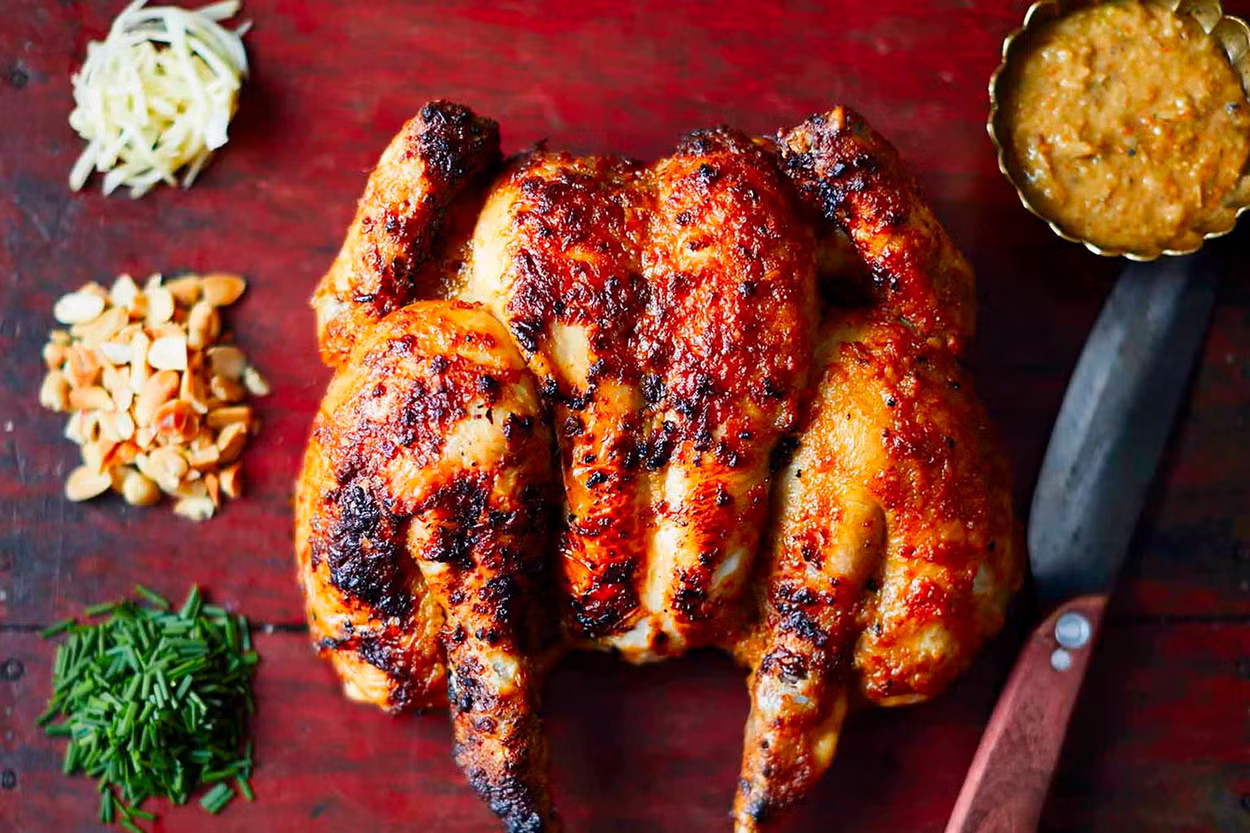
Recipe by: Sebby Holmes
Lamb roasts may be synonymous in the UK with Easter Sunday, but that shouldn’t stop you from exploring less traditional options. Chicken is always a great go-to meat when it comes to a hearty Sunday meal.
Looking for something different to spice up your roast? Try my Thai twist on roast chicken, marinated in sweet, fragrant satay sauce, guaranteed to have you going back for a second plate.
Satay is commonly eaten across Asia and is traditionally used to marinate meats or vegetables before skewering and barbecuing over an open flame. It takes a little dedication to make the curry paste but once you have, marinating and roasting the whole chicken is a breeze.
Serves: 4
Ingredients:
1 whole large chicken, around 1.5kg, corn-fed and free-range
8 large dried red chillies, chopped in half with scissors, soaked in warm water to soften, drained, deseeded
6 banana shallots, peeled
5 garlic cloves, peeled
1 large knob, roughly 40g, peeled ginger
80g desiccated coconut
80g roasted peanuts
500ml coconut cream
2 tbsp fish sauce
2 tbsp palm sugar
Large pinch coarse salt
6 tbsp coconut oil (vegetable oil can be used instead)
Method:
1. Firstly, make the paste. In a large pestle and mortar proceed to pound all ingredients one at a time first. Individually pound each ingredient until the mixture begins to resemble a paste, then remove from the pestle and place to one side. Start with the dried chilli, ginger, garlic, shallots, peanuts, and coconut, using salt as an abrasive if needed. Once all ingredients have had a good bashing, continue to add all the ingredients together in the pestle and mortar until they have all become one paste. It is normal for this process to take quite some time to complete properly. Because of the coconut content, this paste will only last a week or so, so keep the container it’s wrapped in airtight – and refrigerate or freeze.
2. Now cook out the satay curry. In a large non-stick pan add the coconut oil and heat to a high heat. Add the paste and continue to cook out using a metal spoon so you can scrape the paste as it will want to stick to the pan, continue to fry the paste for around 15-20 minutes until the paste darkens slightly and the smell becomes one. I always find when cooking out a curry that you can smell the individual ingredients cooking in turn, until it all blends into one smell once all the ingredients are cooked and fused together. At this stage add the palm sugar and turn the paste down to a medium heat, continue to stir and scrape until the sugar caramelises and the paste begins to darken. When this happens add the fish sauce – adding this moisture to the paste will deglaze any paste that has stuck a little to the pan. Next, take off the heat, add the coconut cream and mix well.
3. Allow this mix to cool and then place the chicken in a tray and cover with the cooked-out curry paste, making sure to completely cover the whole chicken under and over with the cooked paste. Then leave this to marinate for a minimum of 2 hours, ideally overnight.
4. Once marinated, pre-heat an oven to 200C and place the chicken, skin side up, in a non-stick tray, covered with tin foil on the middle shelf for 40-45 minutes, then remove the tin foil and cook for a further 20 minutes to colour the skin. The paste on the top should be beginning to crisp a little and the chicken juices should be running into the curry paste. Check that the chicken is cooked throughout by making an incision at the leg all the way down to the bone and checking if there are any signs of blood. If there is, return to the oven for a further 5-10 minutes until it is cooked, and the juices run clear. For best results use a temperature probe, you can take it out at 75-80C and it will still be moist and succulent. Allow to rest for 5 minutes before serving.
5. Serve with steamed jasmine rice and carve at the centre of the table.
‘Cook Thai’ by Sebby Holmes (Kyle Books, £19.99).
Roast chicken with truffled gnocchi and sage butter

Recipe by: Gizzi Erskine
Serves: 6
Ingredients:
1 tablespoon butter mixed with 3 chopped sage leaves
1 x 2kg organic chicken
Sea salt and freshly ground black pepper
100g cavolo nero, or other seasonal cabbage, shredded
For the truffled gnocchi:
250g evenly sized floury potatoes, baked and still hot
50g Italian “00” flour, plus extra for dusting
Quarter teaspoon fine sea salt
25g parmesan, finely grated, plus extra for serving
1 teaspoon white truffle paste or white truffle oil
1 egg yolk, lightly beaten
For the sage and truffle butter:
30g unsalted butter
A handful of sage leaves
1-2 teaspoons truffle-infused olive oil
Method:
1. Preheat the oven to 220C/gas 7. To make the sage and truffle butter, put the butter and sage in a small pan and cook over a medium heat until the butter is golden brown and smelling nutty. Remove from the heat and stir in the truffle oil.
2. Rub the sage butter under the chicken skin, season with salt and roast for 20 minutes. Lower the oven to 190C/gas 5 and cook for 1 hour, or until the juices run clear. Cover with foil and leave to rest.
3. Meanwhile, make the gnocchi. Scoop the flesh out of the baked potatoes and mash using a potato ricer into a large mixing bowl. Form a well in the centre of the mashed potato, add the flour, salt and cheese and stir together, then gradually mix in the truffle paste and beaten egg.
4. Press the mixture together to form a dough, adding a little more flour if it seems too wet, and tip onto a floured surface. Shape into a long log, then cut into 2cm lengths. Using a fork, press down onto the top of each, then gently squeeze the sides so that the gnocchi resemble pillows.
5. Bring a pan of salted water to a boil, add the gnocchi and cavolo nero and cook for 1–2 minutes, or until the gnocchi have risen to the surface. Strain, add to the butter sauce and fry until the gnocchi are coated and catching in places. Carve or portion the chicken and arrange the gnocchi and cavolo nero on plates. Pile the chicken on top and spoon over the chicken juices from the tin to finish.
‘Skinny Weeks and Weekend Feasts’ by Gizzi Erskine (Quadrille, £19.99).
Roast chicken with sumac and red onions
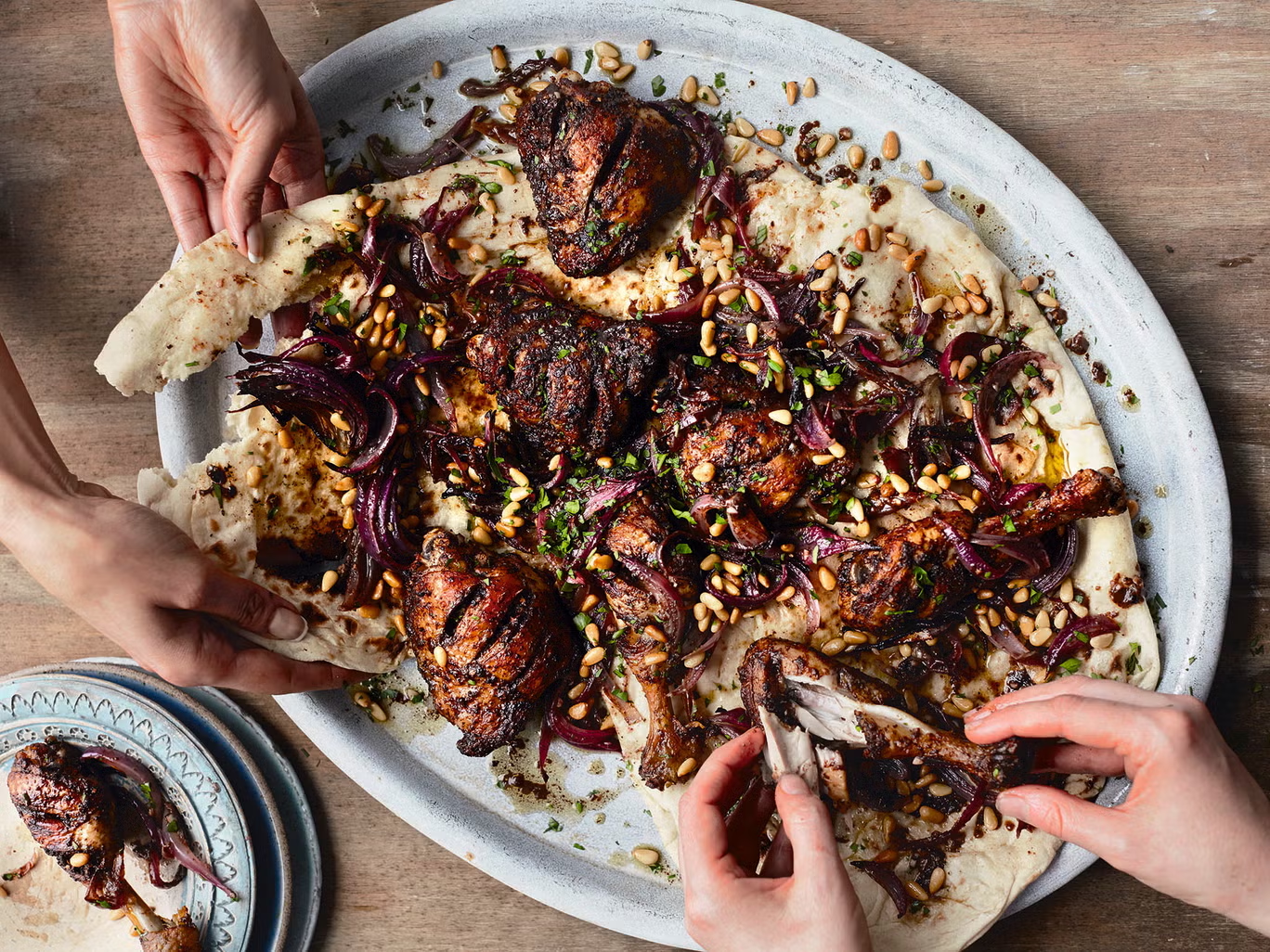
Recipe by: Yasmin Khan
Mussakhan is a classic Palestinian dish eaten in villages throughout the region. Traditionally the meat is laid out on a giant piece of bread with the flavoursome roasting juices poured over it, so that they seep into the dough. This platter is then placed on the table for everyone to pull off sections of bread and chicken: a wonderful sharing meal. As it can be challenging to find such large pieces of flatbread in most shops, I’ve suggested using individual naan breads instead… But, of course, if you can, seek out traditional sheets of Arabic taboon bread from Middle Eastern stores. If you are avoiding gluten, the chicken is just as delicious on its own or served with rice or a salad.
Serves: 4
Ingredients:
1kg chicken thighs and drumsticks, skin on
3 tablespoons extra virgin olive oil, plus more to serve
½ teaspoon ground cumin
½ teaspoon ground allspice
¼ teaspoon ground cinnamon
1½ tablespoons sumac, plus more to dust
Juice of 1 lemon
4 garlic cloves, crushed
Sea salt and freshly ground black pepper
2 large red onions (about 500g), finely sliced into half-moons
2 tablespoons pine nuts
1 tablespoon light olive oil
Naan or Arabic taboon bread, to serve
Chopped parsley leaves
Method:
1. Slash the flesh of each piece of chicken diagonally a few times, around 2cm apart, and then place the meat in a large bowl or plastic food container. Pour over the extra virgin olive oil, spices, lemon juice, garlic, 1½ teaspoons salt and ¼ teaspoon pepper and rub this into the meat. Add the red onions and toss everything together well. Cover and leave to marinate in the fridge for 1-3 hours.
2. When you are ready to cook the chicken, preheat the oven to 190C/fan 170C/gas 5. Transfer the meat to a baking tray and roast for about 35 minutes, or until the chicken juices run clear when pierced at their thickest part. Once the chicken is cooked, cover in foil and leave to rest while you prepare the toppings.
3. Fry the pine nuts in the light olive oil for a minute or so until they turn golden brown, then tip onto kitchen paper to drain.
4. To serve, toast the naan or taboon bread and then place the chicken and red onion on top. Finish with a smattering of pine nuts, sumac and chopped parsley. Drizzle over any remaining roasting juices so they soak into the bread, then sprinkle over a little more extra virgin olive oil.
‘Zaitoun: Recipes and Stories from the Palestinian Kitchen’ by Yasmin Khan (Bloomsbury, £26).
Pan-roasted chicken thighs with pears and fennel
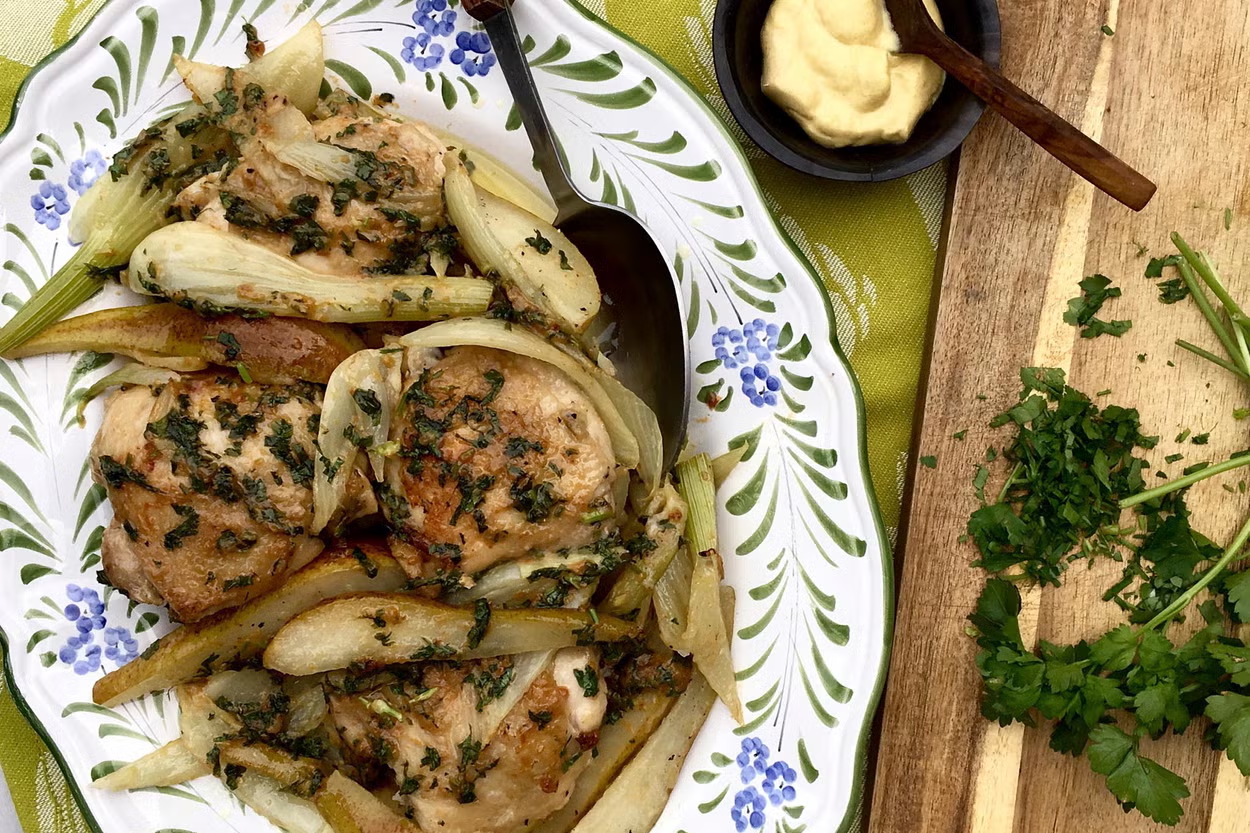
Recipe by: Julia Platt Leonard
“It is, in my view, the duty of an apple to be crisp and crunchable, but a pear should have such a texture as leads to silent consumption.” Food writer Edward Ashdown Bunyard (1878-1939) had a point. While we’d happily pluck an apple off a tree and munch away, we wouldn’t with a pear because it’s not ripe.
A pear picked fresh off the tree is too hard and hasn’t developed the mellow sweetness we want. But give it a bit of time to ripen off the branch and it’s something altogether different.
While pears are a joy to eat raw, they’re not too shabby cooked either. Some heat and a pear’s honeyed tones are revealed nicely.
We’re spoiled for choice with pears in autumn so it’s the perfect time to serve them up in sweet and savoury combinations.
This recipe matches them with bone-in chicken thighs and wedges of fennel that add a nice aniseed bite to the dish. A healthy hit of butter mingled with the juices from the chicken don’t hurt either.
Serves: 3-4
Ingredients:
4 skin-on, bone-in chicken thighs
1 large pear, ripe but firm
1 fennel bulb
25g butter
2 tbsp olive oil
40g plain flour
1 tsp paprika
Juice of 1 lemon
Handful of parsley, chopped
Salt and pepper
Method:
1. Heat the butter and olive oil over medium heat in a heavy pan with a lid that is large enough to hold the chicken thighs. Slice the fennel and pear into 8 wedges each. Place the fennel wedges in the pan, give them a stir to coat in the fat and place the lid on. Cook them for 5-10 minutes until they have softened enough so a knife slips in easily and they’ve darkened in colour. Remove from the pan and place in a bowl.
2. Repeat with the pear. Cooking time for the pear will vary depending on how ripe it is, but around five minutes as well. Remove the pear and add to the fennel.
3. Trim any excess skin and fat from the chicken thighs and set them aside. In a shallow bowl, place the flour and paprika and generously season with salt and pepper. Dredge each thigh in the flour and place skin side down in the pan with the fat. If the fat is running low, add another knob of butter and a splash of olive oil. Cook for about 4-5 minutes until the skin is nicely browned. Turn and cook for another 2-3 minutes then turn down the heat to low or place in a low oven to finish cooking.
4. Pierce a thigh with a skewer to ensure the juices run clear, then remove the thighs from the pan. Add the lemon juice and parsley and turn the heat up to medium-high to deglaze the pan. Add the chicken, fennel and pears back to the pan and cook for a few minutes until everything is warmed through.
Roast chicken with chilli, ginger and lemon
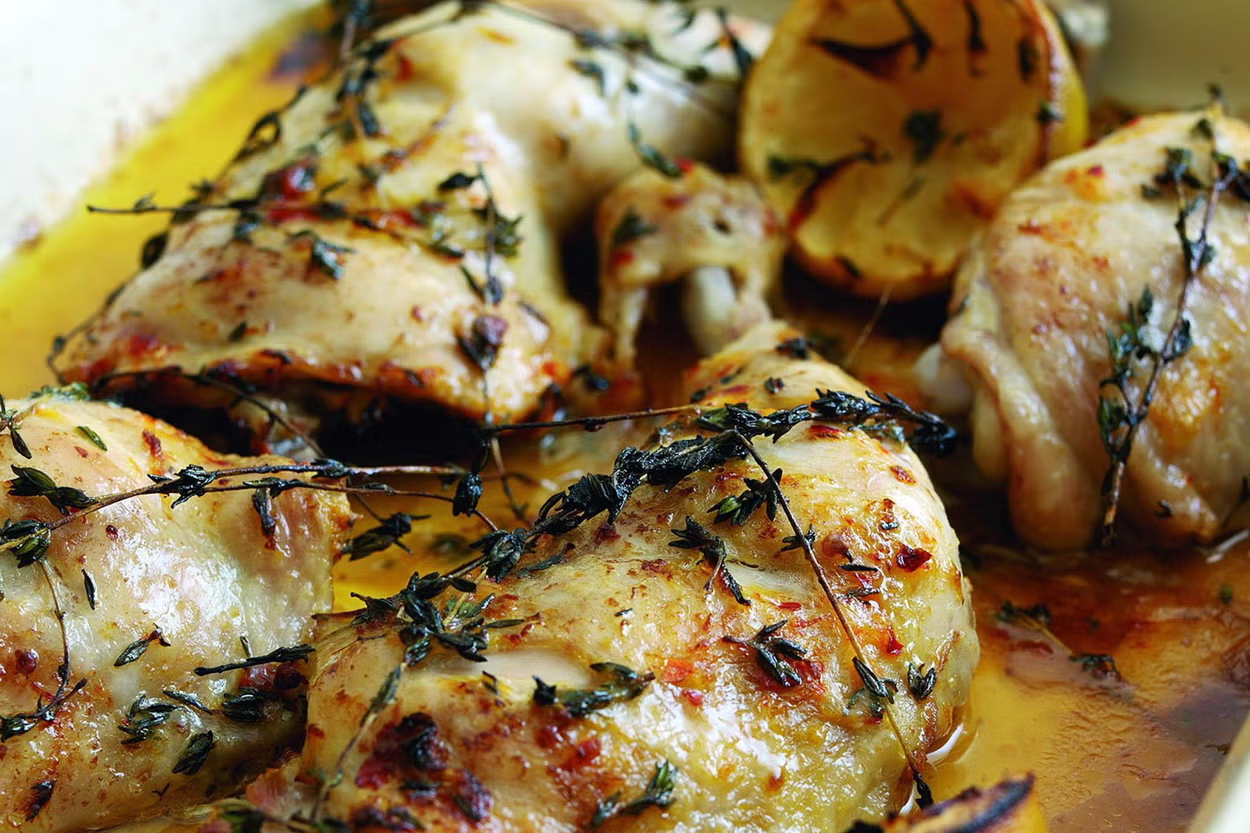
In under 55 minutes create this zesty baked dish made with leg and thigh meat and flavoured with a kick of chilli and ginger.
Serves: 4
Prep time: 15 minutes | Cooking time: 40 minutes
Ingredients:
5 tbsp olive oil
4 large chicken legs and thighs, skin on
2 medium chillies, chopped
Small thumb of ginger, ground
6 sprigs of fresh thyme, some leaves removed
Juice of 2 lemons and zest of 1
Method:
1. Preheat the oven to 200C/fan 180C/gas mark 6.
2. Using a sharp knife, make three shallow incisions in the skin of each chicken leg and thigh then, in a large bowl toss them together with the olive oil, chilli paste and ginger paste, lemon, thyme and some seasoning, making sure each chicken joint is coated well.
3. Add two juiced lemon halves and set aside to marinate for at least 30 minutes if possible.
4. Transfer the chicken and juices into a shallow roasting tin, spreading the chicken and lemon halves into a single layer.
5. Place in the oven for 40 minutes, basting with the pan juices every so often, until the skin is crispy and golden brown.
6. Serve the chicken with a green salad and crusty bread to help mop up the juices.
verylazy.com
Brick roast chicken and braised chipotle cabbage
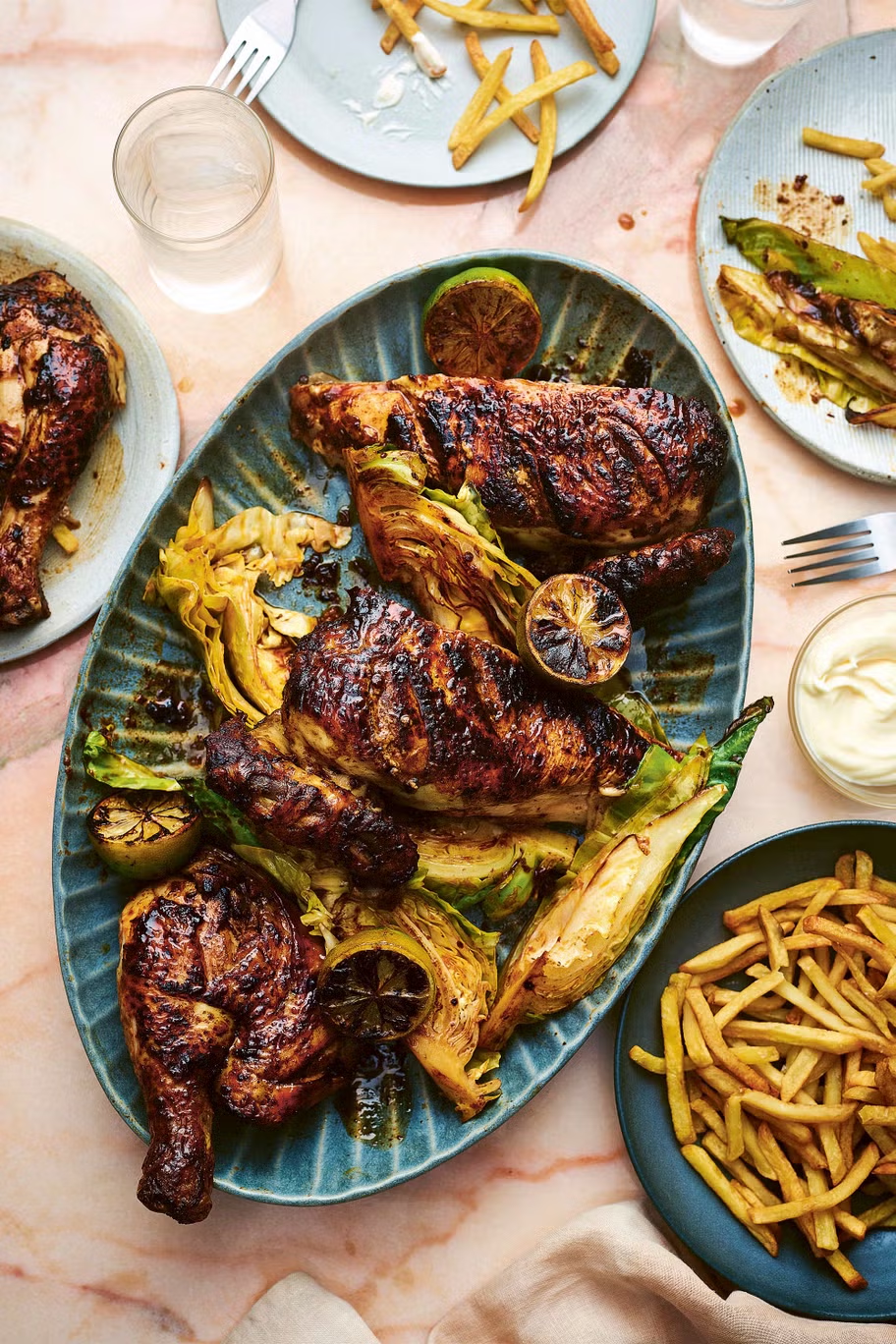
Recipe by: John Torode and Lisa Faulkner
Chicken and just five other ingredients equals a crowd-pleaser with little fuss. You don’t have to use a brick, any heavy weight will do (the brick keeps the chicken flat so the skin stays crisp), but what a great story to tell around the family table – oh yes I got a brick and cooked you a chook!
Serves: 4-6
Ingredients:
1 whole chicken (2-2.5kg)
Juice of 2 limes
100g chipotle paste
Olive oil, for cooking
For the chipotle cabbage:
A little oil, for frying
1 hispi cabbage, cut into 8 wedges
1tsp chipotle paste
200-300ml water
To serve (optional):
Oven fries
Mayonnaise
Method:
1. Preheat the oven to 220C (200C fan). If using a brick, wrap it in foil and heat in the oven.
2. Place the chicken on a board, breast-side down with the parson’s nose towards you. Use a sharp knife, or poultry shears, to spatchcock, by cutting down each side of the parson’s nose. Remove the backbone. Flatten the chicken a bit, turn it over and push it down against the board. Use a sharp knife to make small slashes in the skin. Pierce all over the skin with a fork.
3. Make a marinade with the lime juice and chipotle paste and rub it all over the chicken, back and front.
4. Heat a large ovenproof frying pan and add a little olive oil. Place the chicken skin-side down and let it sizzle. Drizzle with oil once a little coloured, then turn the chicken over. Weigh the chicken down with the heated brick wrapped in foil (thus brick chicken) or use a cast-iron lid. Leave to cook over a medium heat for five minutes then turn and cook the other side for five minutes with the weight on. Transfer to the oven and bake for 40-45 minutes, still weighed down by the brick.
5. Meanwhile, for the cabbage, heat a large frying pan that has a lid, add a splash of oil and place the cabbage wedges in the pan. Cook for three minutes to get some good colour, then turn them. Mix the chipotle paste and water, pour over the cabbage and cook for five minutes, then turn the cabbage and cook until it is soft and the liquid reduces to make a sauce.
6. Remove the chicken from the oven and leave to rest. Place the cabbage on a large platter. Chop the chicken by removing the thighs and chopping the breast in half. Place the chicken on top of the cabbage, swirl the cooking juices in the pan and pour over. If liked, serve with fries and mayonnaise.
Tip: You can use a fire brick in the oven as they are better at withstanding higher temperatures. They can be purchased from DIY stores and online. If you do not have a suitable brick, a cast-iron lid will work.
‘John & Lisa’s Kitchen’ by John Torode and Lisa Faulkner (Quadrille, £25).
Disclaimer: The copyright of this article belongs to the original author. Reposting this article is solely for the purpose of information dissemination and does not constitute any investment advice. If there is any infringement, please contact us immediately. We will make corrections or deletions as necessary. Thank you.



